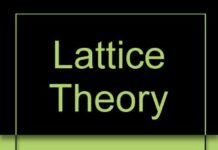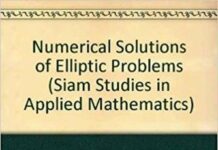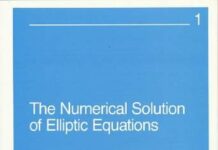
Ebook Info
- Published: 1991
- Number of pages: 399 pages
- Format: PDF
- File Size: 27.37 MB
- Authors: Garrett Birkhoff
Description
A carefully revised edition of the well-respected ODE text, whose unique treatment provides a smooth transition to critical understanding of proofs of basic theorems. First chapters present a rigorous treatment of background material; middle chapters deal in detail with systems of nonlinear differential equations; final chapters are devoted to the study of second-order linear differential equations. The power of the theory of ODE is illustrated throughout by deriving the properties of important special functions, such as Bessel functions, hypergeometric functions, and the more common orthogonal polynomials, from their defining differential equations and boundary conditions. Contains several hundred exercises. Prerequisite is a first course in ODE.
User’s Reviews
Editorial Reviews: About the Author Garrett Birkhoff was an American mathematician. He is best known for his work in lattice theory. The mathematician George Birkhoff was his father. Gian-Carlo Rota is the author of Ordinary Differential Equations, 4th Edition, published by Wiley.
Reviews from Amazon users which were colected at the time this book was published on the website:
⭐good
⭐This text is based upon lecture notes (written either by Rota and then bound by Birkhoff or vice versa) and it is VERY apparant that the authors spent little time on checking for mistakes. It seems as though every fourth problem has a typographical error or is completely incorrect. This textbook does not take an intuitive approach to the subject and the many errors gives me reason to rate it low.Nothing is more frustrating to a student than to have a text make a claim, ask you to prove it, and then you find out the claim is false. This is not a unique occurance. Steer clear of this textbook.
⭐Possibly the best, and certainly the most realistic, mathematics exam question is a statement that you are to prove, if it is true, or for which you’re to provide a counterexample, if it’s false. Since you’re not told whether the statement is true, the first, and frequently hardest, step is to figure out whether you believe it, thus determining whether you next seek a proof or a counterexample. Extra credit is awarded, if you can elegantly amend the hypotheses of a false statement to produce one that’s true and proceed to a proof, which can sometimes seem like an afterthought, once you’ve understood the situation. (For what it’s worth, Birkhoff loved this type of question, when he taught from this book.)I say this type of question is realistic because you find yourself in the same place, when trying to solve a real problem. For example, suppose you know that a certain proposition is true, but some calculations you’re doing would be made easier, if its converse were also true. Your first step isn’t (or shouldn’t be!) to jump in and try to prove the converse. Rather, you ask yourself whether the converse makes sense–i.e., would its truth contradict some other statement that you know to be true, or do other things you know suggest its truth? If it passes this test, you proceed to construct a simple example in which the converse holds, then try to make the example a little more realistic and probably harder, because you’ve weakened its hypotheses. Only after constructing a few examples whose hypotheses don’t seem artificially strong do you finally try to prove the converse. (If your examples are good ones, they may suggest how a proof works but unfortunately not always, especially if the most likely proof is nonconstructive. They will in any case give you an idea of what the hypotheses and any auxiliary conditions should look like.)My point is that in good exam questions and real problems, you almost never know whether what you’re trying to prove is actually true, despite the best evidence you’ve accumulated. Mathematical experience entails time spent trying to prove things later realized to be false–or, almost as-bad, true but uninteresting–because that’s how we learn in any logically rigorous subject. Regrettably, knowledge absent the real frustration of framing appropriate questions is beginner’s luxury soon left behind in the practice of pure or applied science. Indeed, the balance-of-frustration, as it were, not infrequently tilts toward posing the right questions, walking the maze sometimes being less problematic than mapping it in the first place.To my mind this is the best high-end ODE book around, assuming you’ve already worked your way through a book like Braun that emphasizes calculation. Among the more applied texts its main competitor is Carrier and Pearson, but that text is in many ways idiosyncratic because of the authors’ very Socratic approach. If your bent is a bit more theoretical, at this level there are Arnold; Devaney, Hirsch, and Smale; and its predecessor, Hirsch and Smale, which Amazon incorrectly attributes to Smale alone. But the geometric (dynamical-system) approach of these books is sufficiently different from B&R that they’re complements, rather than substitutes. Pretty much the same is true of Hurewicz’s superb older text. At an advanced level Coddington and Levinson remains the best reference, for my purposes at least, despite its age. Arnold’s advanced text is also excellent but again has a geometric emphasis, as its title suggests. (Full citations are in Listmania; see my Amazon profile. I should stress that I’m no doubt ignoring many fine favorites, a few of which appear at the end of my citations, either through unfamiliarity, or because I haven’t actually used them.)The errors in B&R obviously shouldn’t be there. But having been warned, you’ll learn a great deal, if you think of them as practice for problem-solving by making sure you actually believe a statement before you try to prove it. We do this in some measure all the time, of course, but the errors in B&R mean that the reader should sometimes make explicit what’s usually an implicit step. For example, think through the statement’s implications, try to construct counterexamples, and so forth. If you conclude that it”s wrong, ask how the statement’s hypotheses need to be modified to make it work.To wit, my fellow reviewer did finally conclude that an infinite sequence of Sturm-Liouville eigenfunctions is bounded, and his bringing this up in his review suggests that he’s never forgotten it. Thus, for the thoughtful the exercise was successful, if not quite in the way intended, and even if “frustrating [for] a student,” as our learned friend complains. Catching just a few errors in this way will make you so gloriously self-confident that you’ll start probing the questions and problems in every math book you use, which is a very good thing.As the saying goes, “When life gives you lemons [especially the juicy ones, like this book], make lemonade!”A WORD ABOUT COUNTEREXAMPLES. Talented analysts, like mathematicians in other fields, tend to keep a a relatively small number of very carefully constructed counterexamples in mind and try to adapt them to situations that arise as a step toward their understanding. One of my professors, a mathematician of some note (not Birkhoff or Rota but easily in their league), had a counterexample he called the “wandering, shrinking interval” that wrecked many incorrect conjectures, much to his delight. It takes astonishingly few of these counterexamples to be really effective–a dozen, say, may be on the high side, if the counterexamples are well-chosen and evolve over time–and each analyst seems to have his or her own list, with a much larger, less subtle, core of interesting pathologies that all good analysts seem to know.The subtleties ultimately derive from an oral tradition that’s handed down from professor to student, which is the real purpose of advanced instruction at any level. However, a number of books talk about the well-known core in various areas of mathematics–e.g., analysis, topology, topological vector spaces (functional analysis), differential equations, and probability. They can get you started in constructing your own counterexamples, not least by getting you into the conversations where the more sophisticated concepts are discussed; this review’s Listmania page on my profile has pointers.POSTSCRIPT (added 18 Mar 2009). When I read this review after almost a year, I’m struck that there’s no errata in later printings of the Fourth Edition. This edition first appeared in January 1989; Birkhoff died in November 1996; and Rota in April 1999. It seems highly likely that the authors became aware of many errors before their deaths, colleagues and students being what they are, so there probably was ample opportunity to issue such a sheet, if they’d so desired.They may have concluded, however, that corrections are superfluous, because a careful student of mathematics–the type that they tried to reach, and of which there’s never been any shortage in Cambridge–would proceed as I’ve suggested without further ado. Indeed, an instructor can see the uncertainty as beneficial, as it is in the exam questions I’ve described. There’s no knowing at this point, of course, but I would find it quite plausible that they reasoned in this way. –PJES
⭐This is a terrible textbook. After being forced to use it for a class, I can safely say that in every set of problems there are at least 5 errors. I’m not talking about small typos–these errors disrupt the entire problem. Often, the author screws up equations entirely in the problems and randomly changes what he has named each variable. Also, it appears as if the authors didn’t bother to solve out the problems they were doing. Some of the problems lead to long and tedious computation: if you’re in an Ordinary Differential Equations class, you should know how to take a derivative. There’s no point in forcing people to solve a fifth order linear Differential Equation leading to a system of 5 equations, it just wastes time and serves no purpose in illuminating the ideas the authors were trying to teach (try taking the fourth derivative of 4 variations of c*e^((sqrt(2)/2)*x)*sin((sqrt(2)/2)*x) and solving for the constants and you’ll see what I mean). The book is also painfully outdated (Look forward to computers that can calculate to 7 decimal places!!!) rendering entire sections of the book useless. Half of the formulas are wrong anyway and can’t be trusted without verification from someone who is already knowledgeable about the subject. For a book that is so expensive, and in paperback no less, I expected more examples and at least a reasonable editor. Unless you’re forced to buy this book, or enjoy reading an unedited copy that the authors clearly didn’t even look at after they typed, I would highly recommend against wasting so much of your money. Overall, just a terrible terrible textbook all around and not worth even buying as a reference text.
⭐I can’t believe that this is the fourth edition of this book. Considering the lack of organization and typos, I’d think it was an unpublished draft of a book. It’s honestly the worst book I have ever used. I found it harder to learn anything from than rudin. It’s unclear what knowledge is a prerequisite for the material here, as the authors seeem to do some sort of review of first order linear differential equations in the beginning but then go off on different tangents. Often terminology will be left undefined, especially in the exercises where it actually matters the most. One highlight of this happening is the chapter on limit cycles, where no formal definition “limit cycle” is actually given. Perhaps this wouldn’t be too bad, but there are exercises asking to PROVE things about limit cycles. And I assure you that this is not at all an isolated incident.My impression is that the authors attempted to write a terse, rigorous account of differential equations. Instead we get an unmotivated disorganized potpourri of topics whose significance is never made clear.
⭐
Keywords
Free Download Ordinary Differential Equations 4th Edition in PDF format
Ordinary Differential Equations 4th Edition PDF Free Download
Download Ordinary Differential Equations 4th Edition 1991 PDF Free
Ordinary Differential Equations 4th Edition 1991 PDF Free Download
Download Ordinary Differential Equations 4th Edition PDF
Free Download Ebook Ordinary Differential Equations 4th Edition



